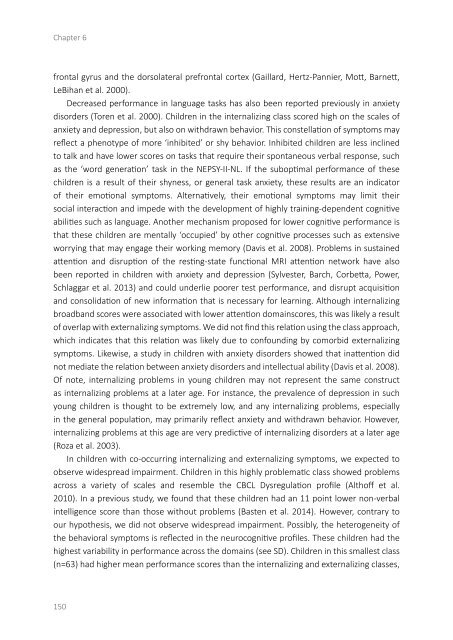On the Spectrum
2lm5UyR
2lm5UyR
You also want an ePaper? Increase the reach of your titles
YUMPU automatically turns print PDFs into web optimized ePapers that Google loves.
Chapter 6<br />
frontal gyrus and <strong>the</strong> dorsolateral prefrontal cortex (Gaillard, Hertz-Pannier, Mott, Barnett,<br />
LeBihan et al. 2000).<br />
Decreased performance in language tasks has also been reported previously in anxiety<br />
disorders (Toren et al. 2000). Children in <strong>the</strong> internalizing class scored high on <strong>the</strong> scales of<br />
anxiety and depression, but also on withdrawn behavior. This constellation of symptoms may<br />
reflect a phenotype of more ‘inhibited’ or shy behavior. Inhibited children are less inclined<br />
to talk and have lower scores on tasks that require <strong>the</strong>ir spontaneous verbal response, such<br />
as <strong>the</strong> ‘word generation’ task in <strong>the</strong> NEPSY-II-NL. If <strong>the</strong> suboptimal performance of <strong>the</strong>se<br />
children is a result of <strong>the</strong>ir shyness, or general task anxiety, <strong>the</strong>se results are an indicator<br />
of <strong>the</strong>ir emotional symptoms. Alternatively, <strong>the</strong>ir emotional symptoms may limit <strong>the</strong>ir<br />
social interaction and impede with <strong>the</strong> development of highly training-dependent cognitive<br />
abilities such as language. Ano<strong>the</strong>r mechanism proposed for lower cognitive performance is<br />
that <strong>the</strong>se children are mentally ‘occupied’ by o<strong>the</strong>r cognitive processes such as extensive<br />
worrying that may engage <strong>the</strong>ir working memory (Davis et al. 2008). Problems in sustained<br />
attention and disruption of <strong>the</strong> resting-state functional MRI attention network have also<br />
been reported in children with anxiety and depression (Sylvester, Barch, Corbetta, Power,<br />
Schlaggar et al. 2013) and could underlie poorer test performance, and disrupt acquisition<br />
and consolidation of new information that is necessary for learning. Although internalizing<br />
broadband scores were associated with lower attention domainscores, this was likely a result<br />
of overlap with externalizing symptoms. We did not find this relation using <strong>the</strong> class approach,<br />
which indicates that this relation was likely due to confounding by comorbid externalizing<br />
symptoms. Likewise, a study in children with anxiety disorders showed that inattention did<br />
not mediate <strong>the</strong> relation between anxiety disorders and intellectual ability (Davis et al. 2008).<br />
Of note, internalizing problems in young children may not represent <strong>the</strong> same construct<br />
as internalizing problems at a later age. For instance, <strong>the</strong> prevalence of depression in such<br />
young children is thought to be extremely low, and any internalizing problems, especially<br />
in <strong>the</strong> general population, may primarily reflect anxiety and withdrawn behavior. However,<br />
internalizing problems at this age are very predictive of internalizing disorders at a later age<br />
(Roza et al. 2003).<br />
In children with co-occurring internalizing and externalizing symptoms, we expected to<br />
observe widespread impairment. Children in this highly problematic class showed problems<br />
across a variety of scales and resemble <strong>the</strong> CBCL Dysregulation profile (Althoff et al.<br />
2010). In a previous study, we found that <strong>the</strong>se children had an 11 point lower non-verbal<br />
intelligence score than those without problems (Basten et al. 2014). However, contrary to<br />
our hypo<strong>the</strong>sis, we did not observe widespread impairment. Possibly, <strong>the</strong> heterogeneity of<br />
<strong>the</strong> behavioral symptoms is reflected in <strong>the</strong> neurocognitive profiles. These children had <strong>the</strong><br />
highest variability in performance across <strong>the</strong> domains (see SD). Children in this smallest class<br />
(n=63) had higher mean performance scores than <strong>the</strong> internalizing and externalizing classes,<br />
150


